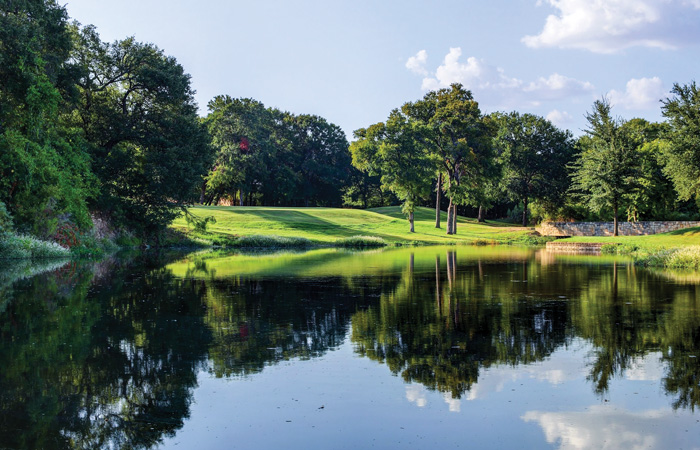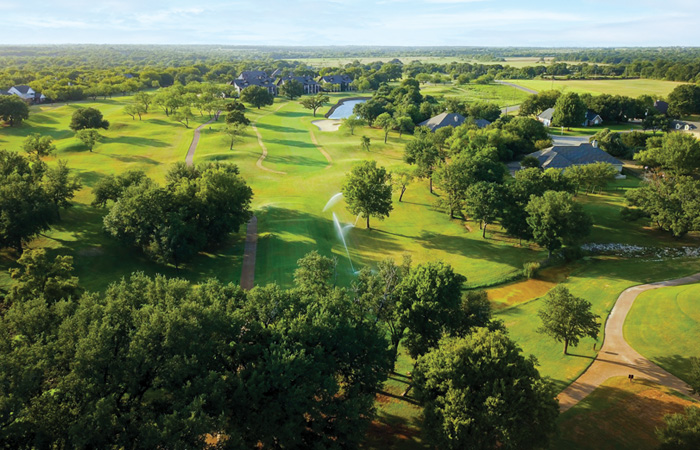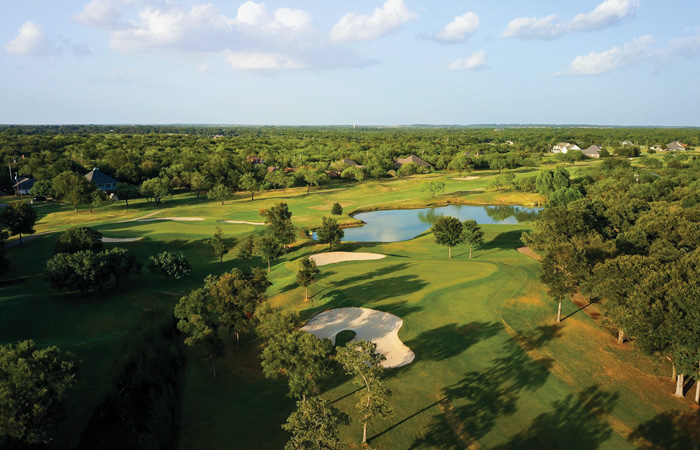White Bluff Resort sits about 90 minutes southwest of the Metroplex in the town of Whitney. Although White Bluff is a gated community of about 800 homes, after a change of management and some renovations a couple years back, both the Old Course and the New Course are open to public play.
As you reach the guard shack and present your name, you are immediately greeted with a friendly hello. If you are a first timer on the property, kindly ask the attendant where you need to go, and they will present you with a map and step by step directions to whichever course you happen to be playing that day.
Designed by Bruce Lietkze and opened in 1992, the Old Course at White Bluff plays as the easier of the two tracks on the property. The course is more generous off the tee than the New Course (more on that later) but has greens that can require precise approach shots to be able to avoid three-putts and avoid big numbers. There are also more drastic elevation changes on the Old Course, with an emphasis on executing pure iron shots and finding proper sections of these massive, undulating greens.

After a relatively tame opening three holes on the Old Course, the par 4 fourth hole is a true test for any golfer. A tough par 4 with a slight dogleg left, this hole requires a precise tee shot with some length to leave most players a mid to long iron remaining to a tough putting surface.
No. 6 on the Old Course is a great opportunity for players to add a birdie to their scorecard. Playing at just 485-yards, this par-5 is reachable for almost all players if they are using the appropriate tee boxes. However, those with local knowledge will tell you to lay up and leave a good wedge number to avoid missing the wrong side of the green. It’s another diabolical putting surface where missing in the wrong spot could leave a putt that is near impossible to get down in two.
The back nine at the Old Course has some of the most scenic views of either 18. The stretch of No. 12 and No. 13 are both awesome, with beautiful panoramic views of Lake Whitney as you reach the green on 12 and proceed to the 13th tee. No. 12 requires an accurate tee shot, as water lies just off the tee box and trees frame the hole not far off the fairway. This hole plays uphill, so it will play longer than the 389-yards it reads on the scorecard, and again, this green can leave players some putts that will make them want to pull their hair out, so make sure you be mindful of where you need to hit the ball on the green and where your good misses are to avoid a disaster.

No. 13 is the signature hole on the Old Course. This par three is tucked into a collection of trees atop a rocky outcropping that provides a stunning view of the lake below. It’s a visually gorgeous hole that can also lead you to a false sense of security. It’s a tough green to hit with all the trouble that catches your eye as you prepare to swing. Short and long are both dead, so although it only plays 158 from the tips, it’s a tough hole to par.
The final three holes on the Old Course can be feast or famine depending on how you’re hitting it. No. 16 is a sharp dogleg right par 4. Avoiding the fairway bunkers is paramount, as you will want to be able to put some spin on your approach shot to avoid finding the wrong section of the putting surface. The green complex here is simply diabolical. Those who miss left when the pin is on the right will see one of the most difficult two-putts imaginable. It’s a fun hole where a four on the card is a good number.
The 17th is the final par 3 of the round. A water feature that runs down the left is being renovated and when complete, will make this one of the most scenic holes on the Old Course. Be mindful of pin position here, as the green is about 100 feet from front to back.
The final hole is a par 5 and one last chance to score before packing it in for the day. It is the shortest par-5 on the course, but requires an accurate tee shot. A pair of trees on the left can knock down tee shots and begin a potential cavalcade of errors if not careful. If you are in the left trees, be mindful to not put too much on your recovery attempt, as balls can scurry through the fairway leaving a third shot that has similar tree issues. A good tee ball leaves a great chance at a closing birdie.
The clubhouse at the Old Course has a bar and grill if you want something at the turn or post-round. There is also a shower and locker room if you might need to rinse off before you head back to the Metroplex.

The New Course at White Bluff has as much character as the Old Course but plays vastly different. While the Old Course has generous fairways and is most often protected by its large carnivorous greens, the New Course is far more claustrophobic and tighter, especially off the tee. On some holes, it seems as if the trees actually want to reach out and grab your ball out of mid-air, and in some cases, they actually do.
Another Lietkze design, this one completed in 1998, opens with some tough holes before giving way to a more links style feel for the remainder of the opening nine, and back into the trees for the back. The inward nine on the new course is a real challenge, with some hard doglegs and one of the toughest par-3’s of either course.
The opening three holes on the New Course really put your off the tee game in the pressure cooker early. The first three holes are extraordinarily tight, the opening pair par 4’s with utmost precision required. The third is a par-3 that plays 215 from the tips with virtually no good miss around the green. If you can get through the first few holes unscathed, you could be in for a good day on the links.
After No. 3, the course opens up for a bit, with 4, 5, 6 and 7 being a gettable stretch, especially with no wind. No. 7 is especially forgiving, with a wide landing area, meaning long hitters can bomb away and try to get a mid-iron in their hands to go at the green in two.
The final hole of the front on the New Course is an appetizer for the more difficult inward nine. Try to keep the drive along the right center for a good angle in at the flag. A short iron should remain, but water short of the green can make for a tricky shot, especially if the wind is coming from the south.
As mentioned, the back nine on the New Course is a tough test of golf. No. 10 sets the tone, with a narrow tee shot that has water in play on the right. Be sure to avoid the greenside bunker on the left or be faced with a very awkward sand save attempt.
After a reachable par-5 and a great chance for birdie at No. 11, the New Course begins to flex its muscles. The signature hole, and for my money, the most interesting hole on the New Course, comes at No. 12. A large exposed rock face in the distance makes this hole a visual delight. Favor the left center of the fairway, but choose wisely from the bag, as too much club could mean a watery grave for your tee shot. Avoiding the huge fairway bunker on the right is also a necessity, as being in it leaves a huge sand face in front of your ball and no view of the green. Players that hit the fairway will have no more than a wedge into this well protected green.

Two more tight par-4’s follow before the greatest challenge on the New Course. Although this par-3 only plays as the No. 15 handicap, this 229-yard par-3 is one that any player would be thrilled to walk away with bogey and head to the next tee. Water all down the left drowns golf balls that drift that way with the predominant winds, and bailing out right doesn’t leave much option either, as while your ball may be on dry land, the chip will be very awkward to a slightly elevated green complex. Any three on the card here is a huge success.
No. 16 is the final par-5 on the New Course. It snakes its way downhill to the right, across a pair of creeks, meaning the premium is usually on the second shot here. There is a narrow plot of land between the two creeks that provides a landing zone for those that choose to layup, but there is an opportunity to make a run at this green in two and assure a birdie or at worst a tap-in par.
The closing hole is a long par 4. At 460-yards, it plays downhill from tee to green, but also usually into the southerly wind, so the yardage is pretty true. A good tee shot leaves a tough mid-iron from a downhill lie that can be tough to hoist in the air. Any ball that comes up a little short and left will find the water. It’s a great finishing hole to a fun test of golf
If you have a group that wants to organize a tournament for a couple days, White Bluff has you covered. There are condos available for rental to house you and your friends for a couple days as you take in the property. Four are currently available, with more being renovated and expected to open in the coming weeks. If you are more of a rustic man, there are also three cabins available near the New Course. I use the term “rustic”, but they are only rustic visually. Inside each cabin is a kitchen, bath, a pair of queen beds a single bed and a pull-out sofa, meaning they can sleep four people. Each cabin also has a charcoal grill out back to cook up some steaks after your round. They are perfect for a weekend golf event with you and your buddies.
White Bluff is far enough out of town to have that vacation feel without the beatdown of driving four or more hours to some of the other major golf destinations in the state. Both courses are unique in their own right, with plenty of scorable holes and plenty that can sneak up on you and do some damage to your scorecard. Factor in some fun accommodations for you and your group, and White Bluff is a fantastic place for a day of 36 on the links, or a weekend of relaxation with some friends.
White Bluff Golf Resort
20022 Misty Valley Circle
Whitney, TX 76692
254-694-3610
www.whitbluffresort.com